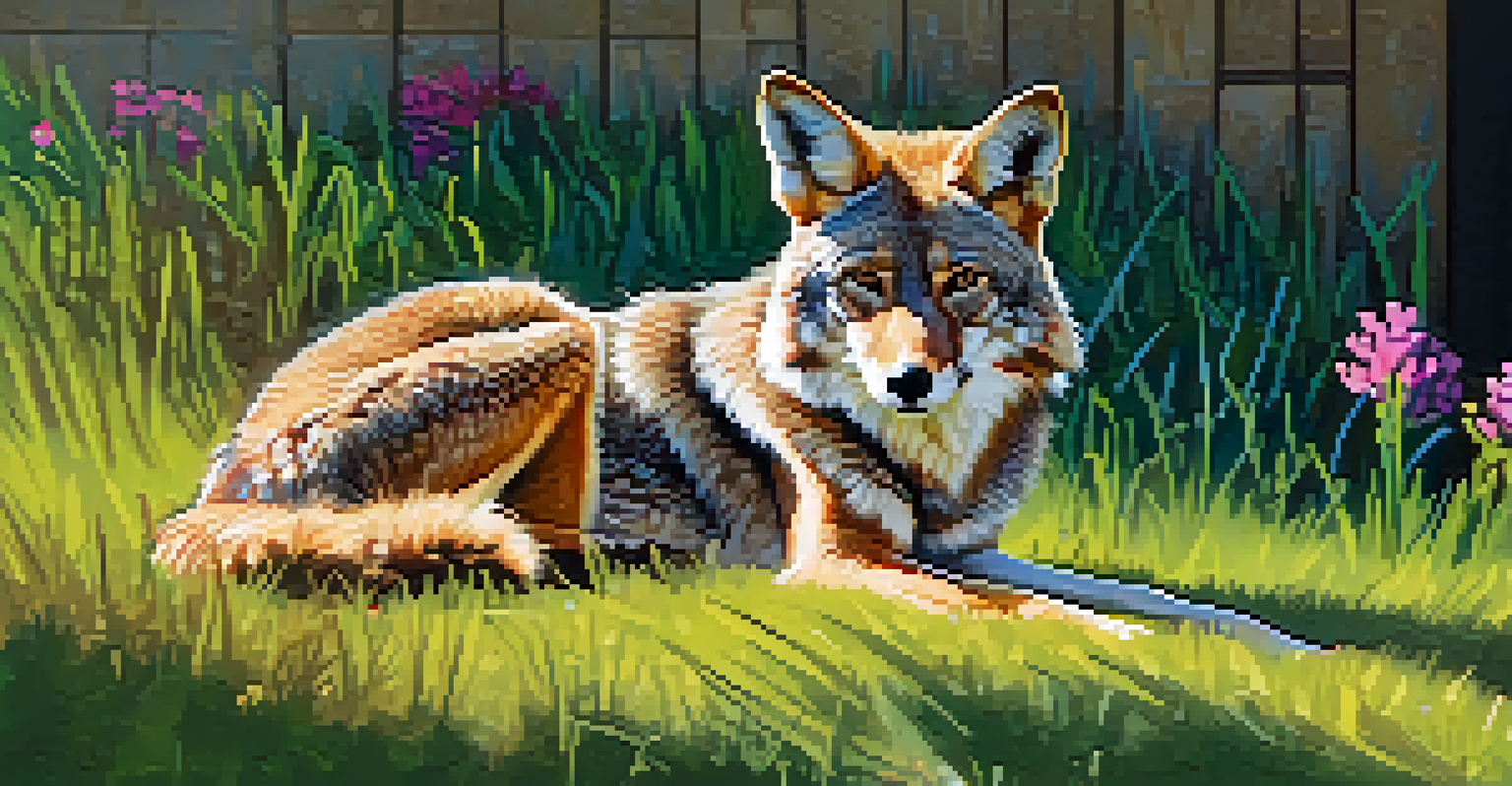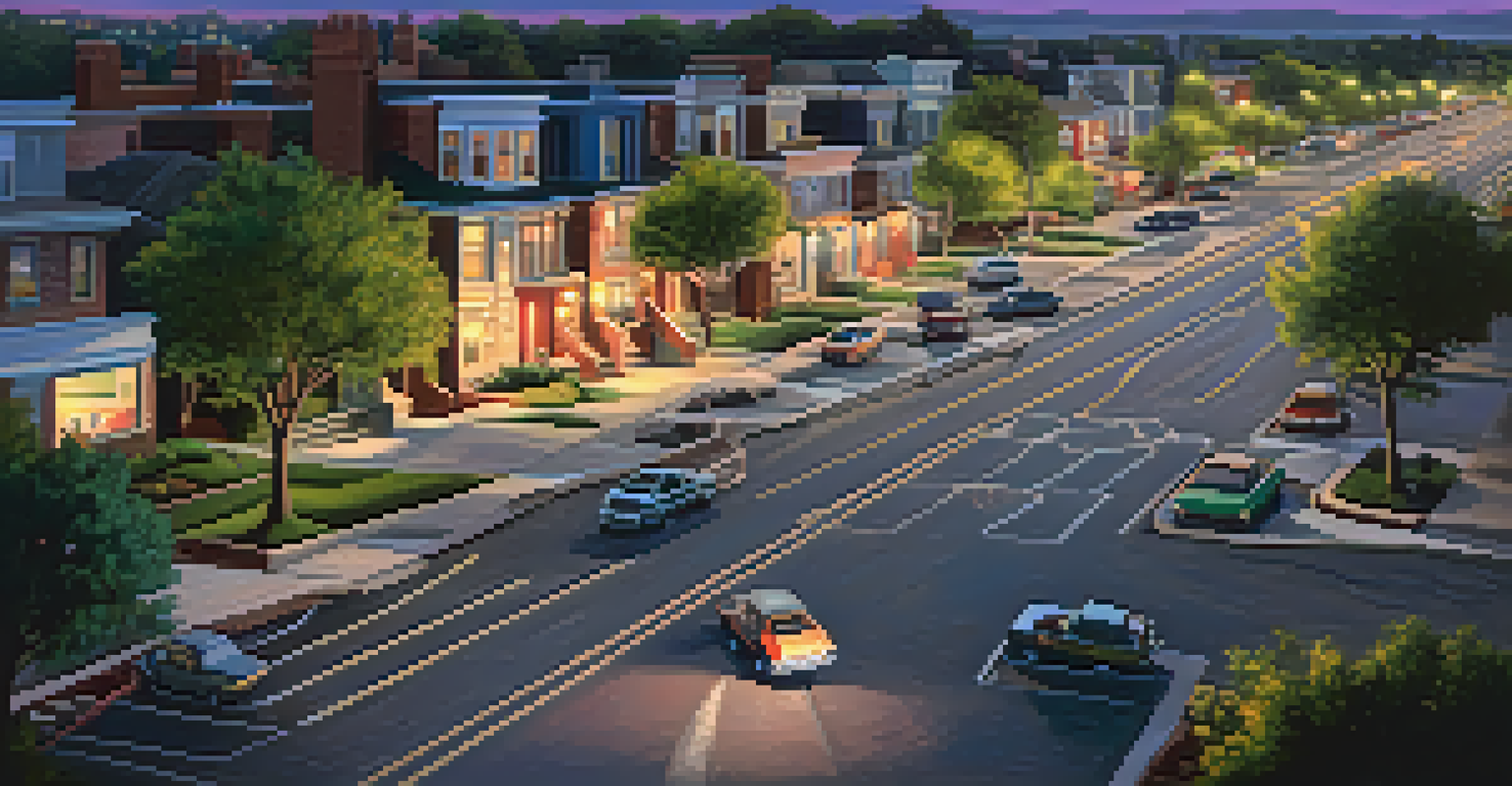California's Urban Coyotes: Adapting to City Life

Understanding Urban Coyotes: Nature's City Dwellers
Coyotes have been a part of California's landscape for centuries, but their increasing presence in urban areas is a fascinating development. These adaptable creatures are known for their intelligence and resourcefulness, allowing them to thrive in human-dominated landscapes. Understanding their behavior helps us appreciate how they navigate the complexities of city life.
Coyotes are adaptable animals that thrive in a variety of environments, including urban areas.
Urban coyotes often hunt and forage at night, taking advantage of quieter streets and less human activity. Their diet can vary widely, from small mammals to scavenged food from trash cans, showcasing their incredible adaptability. This ability to exploit diverse food sources is a key reason why they have flourished in urban settings.
Interestingly, the urban environment offers both challenges and opportunities for coyotes. While they must contend with traffic and human interaction, cities provide ample shelter and food. This unique blend of risks and resources has made them a symbol of resilience in adapting to changing landscapes.
The Role of Urbanization in Coyote Behavior
Urbanization has transformed natural habitats into bustling cityscapes, but coyotes have found ways to adjust. Their behavior shifts in response to urban pressures, such as increased noise and human presence. This adaptability is a testament to their survival instincts, allowing them to thrive even in less-than-ideal conditions.

For example, while rural coyotes may be more territorial, urban coyotes often display more flexible social structures. They tend to roam further and form larger packs when resources are plentiful. This shift allows them to better navigate the urban jungle, where opportunities can vary from block to block.
Urban Coyotes Are Adaptive Survivors
Coyotes thrive in urban environments by adjusting their behavior and diet, showcasing their remarkable adaptability.
Moreover, urban coyotes are becoming increasingly nocturnal, avoiding the peak hours of human activity. This behavioral change not only keeps them safer but also allows them to exploit food sources that would otherwise be inaccessible during the day. Their ability to adapt illustrates the resilience of wildlife in the face of human expansion.
Challenges Faced by Urban Coyotes
Despite their adaptability, urban coyotes face numerous challenges in city life. One of the most significant issues is vehicle traffic, which poses a constant threat to their safety. With roads cutting through their territories, the risk of accidents increases, making it crucial for them to navigate carefully.
To coexist with wildlife, we must understand their behavior and embrace our role in the ecosystem.
Additionally, interactions with humans can lead to conflicts. While many people appreciate these animals, others may view them as pests, leading to efforts to control their populations. Such measures can disrupt their natural behaviors and put additional stress on these adaptable creatures.
Lastly, urban coyotes must also compete with other predators, such as domestic dogs, for resources. This competition can limit their access to food and safe spaces, forcing them to adapt even further. Understanding these challenges is essential for fostering coexistence between humans and these remarkable animals.
Coexisting with Urban Coyotes: Best Practices
Living alongside urban coyotes requires awareness and proactive measures from residents. One important practice is securing trash and food sources, which helps deter coyotes from scavenging in neighborhoods. By making food less accessible, we can reduce their presence in residential areas.
Additionally, educating the community about coyote behavior can foster a better understanding and reduce fear. Knowing that these animals generally avoid human interaction can help residents feel more comfortable. Awareness campaigns can provide tips on how to coexist peacefully without resorting to harmful measures.
Coexistence Requires Community Action
Residents can help foster harmony with urban coyotes by securing food sources and educating themselves about coyote behavior.
Lastly, keeping pets safe is crucial in coyote-prone areas. Simple steps, like supervising pets outdoors and avoiding leaving food outside, can greatly reduce the chances of conflict. By taking these precautions, we can create a harmonious environment where both humans and coyotes can thrive.
The Impact of Urban Coyotes on Ecosystems
Urban coyotes play a significant role in maintaining balance within city ecosystems. As natural predators, they help control populations of smaller mammals, such as rabbits and rodents, which can otherwise become overpopulated. This predation helps promote biodiversity and contributes to healthier urban environments.
Moreover, their presence can influence the behavior of other wildlife species. For example, the fear of coyotes may keep certain animals, like squirrels, from venturing too close to human activity. This natural regulation can create a more balanced ecosystem, showcasing the important role urban coyotes play as apex predators.
Recognizing the ecological importance of these animals encourages us to view them not just as pests but as integral components of our urban landscapes. By understanding their role, we can appreciate their presence and work towards solutions that benefit both wildlife and human communities.
Research and Conservation Efforts for Urban Coyotes
Ongoing research is crucial for understanding the dynamics of urban coyote populations. Scientists are studying their behavior, movement patterns, and interactions with humans to develop effective conservation strategies. This research helps inform local governments and communities on how to manage and coexist with these animals.
Conservation efforts often involve public education campaigns that emphasize the ecological benefits of coyotes. By highlighting their role in controlling rodent populations and maintaining biodiversity, these initiatives can foster a deeper appreciation for these adaptable creatures. Engaging with the community is key to successful conservation.
Coyotes Help Balance Urban Ecosystems
As apex predators, urban coyotes play a crucial role in controlling populations of smaller mammals, promoting biodiversity in city landscapes.
Moreover, collaboration between wildlife organizations and urban planners can lead to more effective policies. By integrating wildlife considerations into urban development, we can create spaces that support both human needs and wildlife habitats. This holistic approach can ensure that urban coyotes continue to thrive alongside city dwellers.
Conclusion: Embracing Urban Coyotes in California
California's urban coyotes are a testament to nature's resilience and adaptability. By understanding their behaviors and challenges, we can create a harmonious coexistence that benefits both wildlife and human communities. Embracing these remarkable creatures allows us to appreciate the complexities of urban ecosystems.
As we continue to navigate the realities of urbanization, fostering a spirit of coexistence is essential. This means advocating for practices that protect both coyotes and human interests, ensuring that urban environments remain vibrant and diverse. Together, we can create a future where urban coyotes are valued members of our communities.

Ultimately, our relationship with urban wildlife reflects our values as a society. By embracing the presence of coyotes in our cities, we acknowledge the importance of biodiversity and the need to protect our natural heritage. In doing so, we not only enrich our lives but also contribute to a healthier planet.